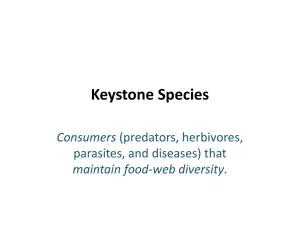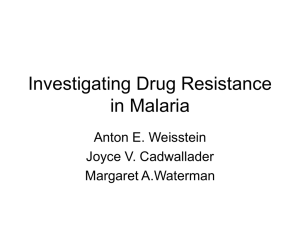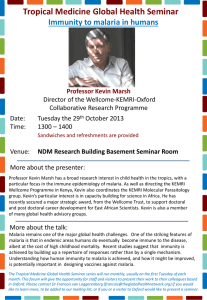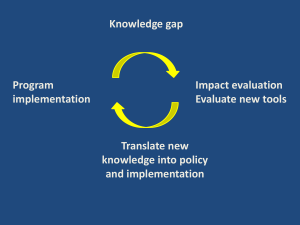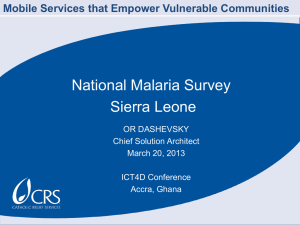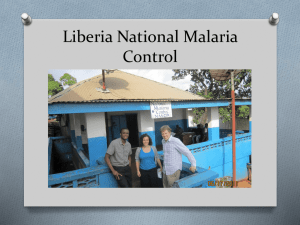Malaria the disease
advertisement
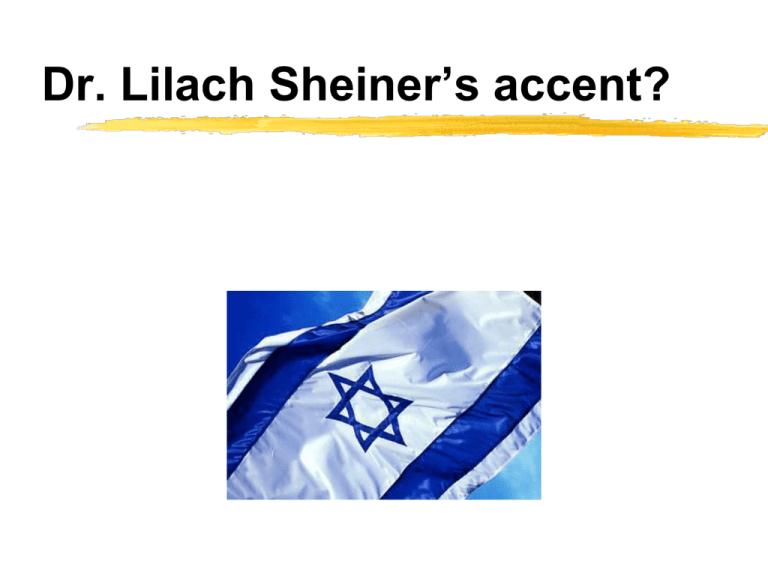
Dr. Lilach Sheiner’s accent? Apicomplexan invasion Active, parasite driven process Depends on parasite actin/myosin motility (conveyor belt model) Involves secretion of micronemes (attachment, motility), rhoptries (PV & MJ formation) and dense granules (makes PV into a suitable home) Sets up a parasitophorous vacuole which initially is derived from the host cell cell-membrane A moving junction is formed which screens out host membrane proteins from the PV, the PV is fusion incompetent and the parasite protected Two great movie clips summarizing the malaria life cycle: Development in the human: http://www.hhmi.org/biointeractive/disease/malaria_anim/malariahuman.html Development in the mosquito: http://www.youtube.com/watch?v=7sHB56AjHQ8&feature=related (Best done before Thursday) Malaria II Malaria the disease Pathogenesis of severe falciparum malaria Drugs used to treat malaria and the development of drug resistance Malaria the disease Human malaria is primarily a blood disease, however it causes pathology in a variety of organs & tissues All disease is due to the parasites development within the red blood cell (merozoite, trophozoite, schizont). Other stages are important for transmission but they do not contribute to pathogenesis Malaria the disease 9-14 day incubation period Fever, chills, headache, back and joint pain Gastrointestinal symptoms (nausea, vomiting, etc.) Malaria the disease Malaria the disease Malaria tertiana: 48h between fevers (P. vivax and ovale) Malaria quartana: 72h between fevers (P. malariae) Malaria tropica: irregular high fever (P. falciparum) Malaria the disease Symptoms intensify Irregular high fever Anxiety, delirium and other mental problems Sweating, increased pulse rate, severe exhaustion Worsening GI symptoms Enlarged spleen and liver Malaria the disease 3 Severe manifestations Cerebral malaria Irritability, loss of reflexes, neurological symptoms similar to menigitis, coma 20% fatality Severe anemia Progressive severe drop of hematocrit, poor oxygen Supply for organs and tissues Renal failure Dwindling urine, high urea Level in serum, hyperventilation Coma, poor prognosis Malaria the disease WHO-TDR Pathogenesis of malaria In highly endemic areas: high mortality among children due to severe anemia, children who survive beyond the first years show decreasing parasitemia and disease (this immunity is not sterile and depends on constant exposure) In areas with less infection pressure: malaria is an epidemic disease with varying intensity. Adults and children are equally susceptible and death in adults is mostly due to cerebral malaria Pathogenesis of malaria Parasitemia Anemia Age Cerebral malaria Pathogenesis of cerebral malaria Cerebral malaria is characterized by multiple brain hemorrhages (vessel rupture and bleeding) Excessive serum and tissue levels of TNFa and INFg (two important cytokines driving inflammation) are associated with severe malaria Some researchers believe this inflammation is the main cause for pathology (remember the immunology introduction: an overshooting immune response against a chronic pathogen that can not be cleared can cause severe disease) Sequestration & cytoadherence Ring stages The second model suggests sequestration to be the main culprit In P. falciparum infections only early stages (rings) are found in the peripheral blood Trophozoites and schizonts are sequestered to the postcapilary venules by attachment to the endothelium Pathogenesis of falciparum malaria Parasite infected RBC become ‘sticky’ and adhere to endothelial cells This phenomenon takes about 10-12 hours to develop after parasite invasion Under high flow (here modeled using a microfluidic device) this first results in rolling and then in attachment Pathogenesis of falciparum malaria Cytoadherence seems to be the main culprit for pathogenesis Infected RBCs will adhere to the endothelium as well as to each other and cause clogging and hemorhaging Note that high cytokine levels induce expression of endothelial adhesins -inflammation makes the endothelia ‘stickier’ Adherence and inflammation reinforce each other in an unholy circle causing pathology Knobs and cytoadherence Cytoadhrence correlates with the presence of “knobs” (left column) on the surface of the infected RBC The right column shows a RBC infected with a knobless strain which does not cause cerebral malaria Knobs are made up of parasite derived proteins knobs knob-less Knobs and cytoadherence PfEMP1 (P. falciparum erythrocyte membrane protein) is found in knobs and is responsible for cytoadherence and rosetting PfEMP1 is a large membrane protein anchored in the RBC membrane with the bulk extending into the blood stream Various domains of PfEMP1 have been shown to bind to ligands on the endothelia of the vasculature and the placenta PfEMP1 is an important pathogenesis factor Knobs and cytoadherence The parasite exports PfEMP1 and other proteins (this picture is showing Knob associated protein) into the RBC and its surface to form knobs F: in early rings protein is in the parasite and the parasitophorous vacuole, G,H: in trophozoites it is found first within the RBC cytoplasm and then at the RBC membrane (I). Knobs and cytoadherence How precisely the parasite transports proteins through the RBC is still under study However it is clear that the parasite has not only to provide the cargo but also the transport machinery as the RBC has reduced its capability for membrane transport and secretion All these proteins are initially secreted by the parasite into the parasitophorous vacuole A recently discovered gatekeeper in the vacuole membrane appears to shuttle proteins across (PTEX Plasmodium translocon of exported proteins) Maurer’s clefts (parasite induced membranous structures in the RBC) appear to be an important bridgehead acting in the sorting and trafficking of exported proteins Chinchona the source of quinine Peruvian Indians appear to have been the first to know about the medicinal effects of quinine, they chewed Chinchona bark while working in the mines as forced laborers for the Spanish Jesuits brought the bark back to Europe to treat febrile diseases In the early 1600s the bark was used to treat the fever of the Countess of Chinchon and became well known as Jesuit’s powder or Peruvian bark Initial preparations were often quite variable in the amount of active ingredient resulting in varying effects Chichona the source of quinine High demand had brought the Chinchona tree almost to extinction in the wild Charles Ledger a trader in Peru send out Manuel Incra Macrami to collect seeds from a stand of special trees they had found earlier After three years Manuel came back with 15 kg of seeds which they sold for 100 guilders to the Dutch consul as the British were not interested C. ledgeriana formed the basis of a very profitable Dutch quinine monopoly which lasted until World War II Chloroquine the wonder drug Chloroquine, a synthetic quinine analog developed by German and American chemists during WWII, was a very potent drug that was cheap to make, stable, and had no serious side effects Chloroquine was a major component of the 60/70s malaria eradication campaign None of the drugs developed since come close to chloroquine Chloroquine the wonder drug During its development within the RBC the malaria parasite ingests the cytoplasma of its host Note that in this schematic (and in real micrographs) the red color of the blood cell gets considerably lighter -- at the same time malaria pigment accumulates The parasite digests large ammounts of hemoglobin to cover part of its amino acid needs Chloroquine the wonder drug RBC cytoplasm is taken up by endocytosis The endocytosis vesicle fuse with the food vacuole (a homolog of the secondary lysosome) were hemoglobin digestion occurs Digestion frees large ammounts of heme Heme is toxic to the parasite and is neutralized by polymerization into the malaria pigment or hemozoin Chloroquine accumulates in the food vacuole (it’s a weak base and like all lysosomes the FV is an acidic compartment) Chloroquine is thought to interfere with the polymerization and detoxification of heme Resistance to chloroquine 1960 1965 1978 1989 http://www.tigr.org/tdb/edb/pfdb/CQR.html Mechanisms of drug resistance Mechanisms of drug resistance Changes in target enzyme (e.g. decreased affinity to drug) Overexpression of target (amplification) Decreased activation of drug Changes in accessibility (less import, or more export of drug) Resistance to chloroquine PfCRT, resistance mutations highlighted Genetic studies have shown that resistance is linked to the transporter protein PfCRT Studies using parasite cultures suggests that a series of point mutations in PfCRT are responsible for resistance This putative transporter localizes to the membrane of the food vacuole Large field studies have found strong association of these mutations with chloroquine resistance Currently it is not known what the physiological function of PfCRT is Antifolates as malaria drugs Nucleotide synthesis dUMP dTMP Tetrahydrofolate The synthesis of certain building blocks of DNA requires reduced folate (more specifically the syntheisis of dTMP) No reduced folate -- no DNA The malaria drug Fansidar uses a drug combination to hit the same target pathway twice Combinations that are more effective than the sum of their individual activities are called synergistic Antifolates as malaria drugs Parasite GTP Folate synthesis Dihydrofolate Folate ‘recharging’ Tetrahydrofolate Antifolates as malaria drugs Parasite Human GTP Folate synthesis Dihydrofolate Dihydrofolate Folate ‘recharging’ Nucleotide synthesis Tetrahydrofolate Tetrahydrofolate Antifolates as malaria drugs Parasite Human GTP Folate synthesis Sulfonamide Dihydrofolate Dihydrofolate Folate ‘recharging’ Nucleotide synthesis Tetrahydrofolate Tetrahydrofolate Antifolates as malaria drugs Parasite Human GTP Folate synthesis Sulfonamide Dihydrofolate Folate ‘recharging’ Dihydrofolate Nucleotide synthesis Pyrimethamine Tetrahydrofolate Tetrahydrofolate Antifolates as malaria drugs Parasite GTP Folate synthesis Sulfonamide Dihydrofolate Folate ‘recharging’ Pyrimethamine Tetrahydrofolate First strike: Folate synthesis. We can’t make folate and take it up with food as a vitamin. The parasite makes it and is therefore susceptible to sulfonamides which block synthesis Second strike: After each use dihydrofolate has to be reduced again (think of it as recharging). The enzyme which does this (dihydrofolate reductase) is different in human and parasite The drug pyrimethamine inhibits parasite DHFR but not human DHFR Fansidar combines pyrimethamine with sulfadoxine A very similar drug combination is used to treat toxoplasmosis Antifolate resistance developed very fast Combinations of Artemisinin and other antimalarials are promising Extracts of Artemisia annua (sweet wormwood) have long been used in traditional Chinese medicine to treat fever Chinese investigators extracted the active ingredients and showed that they and there chemical modifications are powerful antimalarials However monotherapy results in high level of recrudescence Combining Artemisinin with other drugs have been very successful especially for severe malaria Artemisinin acts very fast which helps to reduce mortality and get patients out of their coma quickly Summary Severe forms of malaria include: severe anemia in kids, and cerebral and renal malaria in adults Severe pathogenesis is related to adherence of infected RBC to entothelia Adherence is mediate by knobs in the RBC surface made up by parasite proteins (PFEMP1) PFEMP1 undergoes antigenic variation Chloroquine resistance has been a public health catastrophe Chloroquine accumulates in the food vacuole and prevents heme polymerization, resistance is linked to mutations in a transport protein in the food vacuole membrane Immunity to malaria There is no sterile immunity to malaria Patients produce strong antibody responses to PfEMP1 which is exposed to the immune system on the surface of the infected RBC. Why is the immunity to malaria relatively weak? PfEMP1 is encoded by a large multigene family (VAR genes) and parasites switch to new variants (antigenic variation again) The parasite genome encodes 60 VAR genes, only one is expressed at a time (allelic exclusion) Immunity to malaria Successful vaccination in humans has been achieved with large doses of irradiated sporozoites, however that is likely not practical Many approaches have been and are explored to stimulate immunity against sporozoites (infection blocking), merozoites (disease blocking) or gametocytes (transmission blocking) None has yielded a satisfactory and safe human vaccine yet The most promising new strategies use genetic manipulation to engineer attenuated parasites strains (parasites that enter cells and induce immunity yet fail to develop fully and cause disease) For now, control depends heavily on drug therapy
